Woodpeckers are fascinating birds that live in various parts of Illinois. In this article, we will explore seven different species of woodpeckers and provide you with pictures, an ID guide, and information about their common locations. So if you’re a bird enthusiast or just curious about these amazing creatures, keep reading to learn more!
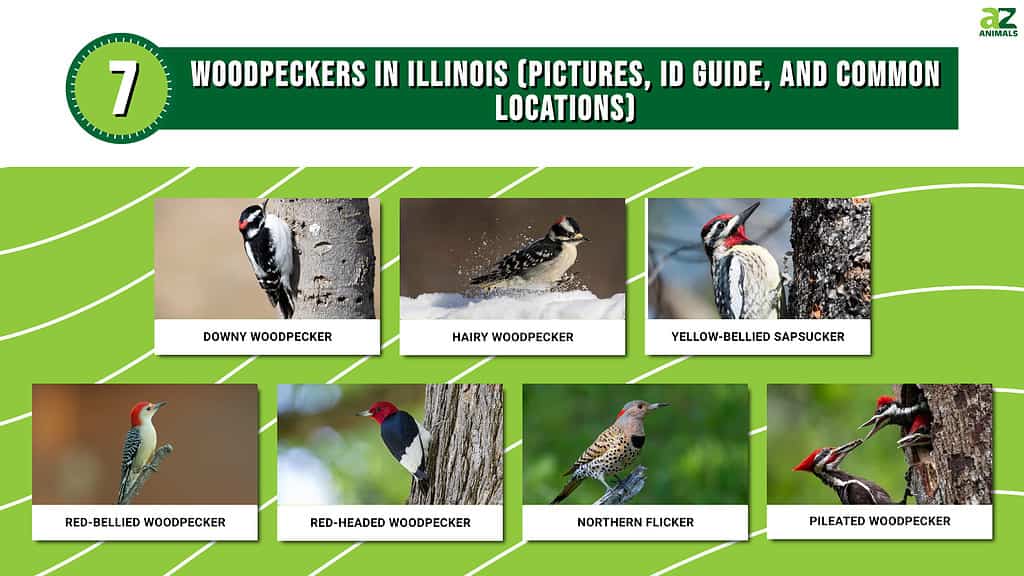
What is a Woodpecker?
Woodpeckers are fascinating birds that live all over the world. They make distinctive pecking sounds and have the ability to use their beaks to carve out cavities in trees. They are also unique among birds in that they have two toes pointing forward and two toes pointing backward, which helps them to grip the bark of trees. Woodpeckers feed on insects, nuts, and other small animals. They are important for the health of forest ecosystems, as they help to control insect populations and disperse seeds. Woodpeckers also play an important role in the culture of many cultures, appearing in myths, stories, and artwork.
Where Do Woodpeckers Live in Illinois?
In the state of Illinois, woodpeckers can be spotted throughout the year. Four species – Downy Woodpeckers, Hairy Woodpeckers, Red-bellied Woodpeckers, and Pileated Woodpeckers – are permanent residents in the region. These birds have adapted to the local habitat, and you can see them all year long.
While some woodpecker species migrate during certain seasons, Northern Flickers and Red-headed Woodpeckers still make appearances in Illinois, even during winter months. These migratory individuals defy expectations by choosing to spend their colder days within the state’s borders.
Among these migrants is another fascinating woodpecker known as the Yellow-bellied Sapsucker. Although they do not reside permanently in Illinois, these birds make two seasonal visits each year. During April and May, as well as September and October, they pass through on their way to or from nesting sites further north.
7 Types of Woodpeckers in Illinois
In Illinois, there are seven varieties of woodpeckers. You can identify them by the presence of red feathers on the heads of males. Here are detailed descriptions of each one.
Downy Woodpecker
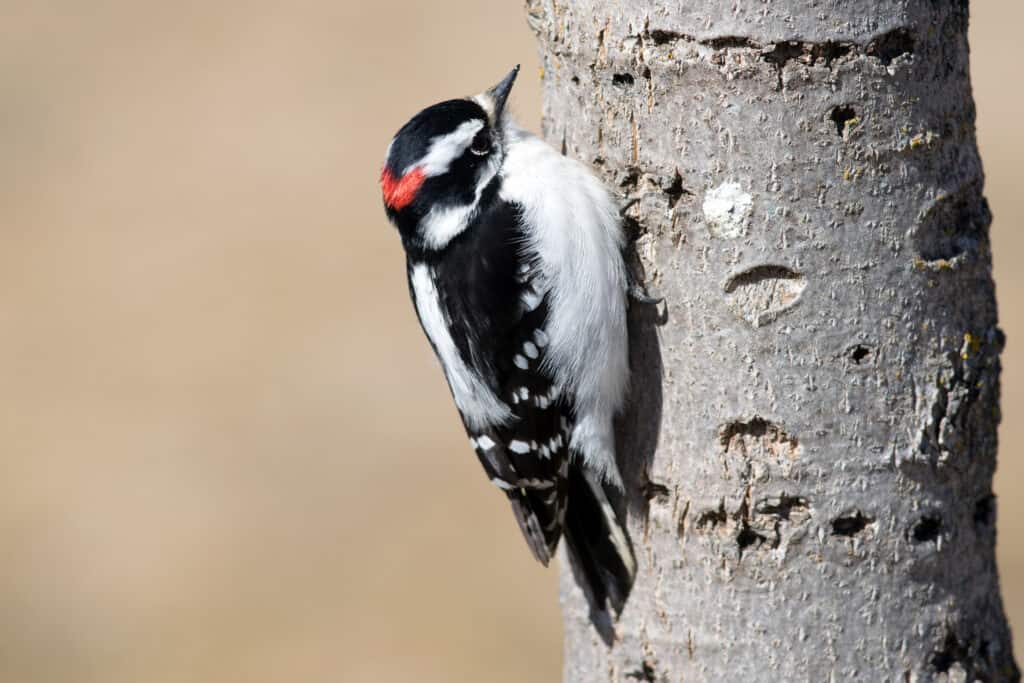
If you hear someone knocking on your gutters in Illinois, it might be a downy woodpecker.
©Northernguy/Shutterstock.com
The downy woodpecker (Picoides pubescens) is a charming and diminutive species of woodpecker that lives throughout Illinois. Measuring approximately 6½ inches in length, this black and white bird may be small in size but certainly not in character.
One of the key features that set the downy woodpecker apart from its relatives is its distinctive field marks. The most prominent distinguishing characteristics are its striking white back and petite bill. These two unique traits make it relatively easy to identify this species among other woodpeckers in the region.
Interestingly, there is also a subtle difference between male and female downy woodpeckers. While both share the same elegant coloration patterns, males possess an additional touch of vibrant red on the back of their heads. This patch of red feathers serves as a distinguishing mark for males, allowing observers to differentiate them from their female counterparts who lack this feature.
When exploring woodland areas or even suburban gardens across Illinois, keep an eye out for these delightful creatures, diligently pecking away at tree trunks or probing for insects hidden beneath the bark. Their small size grants them great agility as they move deftly along branches with ease.
Downy woodpeckers have adapted well to various habitats within Illinois, including deciduous forests, parks, orchards, and even backyard feeders equipped with suet or sunflower seeds. If you provide them with suitable nesting sites, such as dead trees or nest boxes during the breeding season, they will stick around.
Hairy Woodpecker

In Illinois, hairy woodpeckers are year-round residents.
©sandymsj/Shutterstock.com
The hairy woodpecker is a black and white woodpecker that is around 9½ inches long. It is easily identifiable by its white back, which distinguishes it from other woodpeckers. While its plumage is almost identical to that of the downy woodpecker, the hairy woodpecker is larger in size and has a longer bill. Male hairy woodpeckers can be further distinguished from females by the red patch on the back of their heads.
Hairy woodpeckers live primarily in deciduous and mixed forests in North America, but they can also be found in wooded residential areas. They feed on a variety of insects, larvae, and some fruit, but their diet mainly consists of insects from trees and dead wood. They nest in the cavities of trees, often drilling several holes to create a nesting site.
Hairy woodpeckers are important members of their ecosystems, helping to control insect populations and maintain healthy forests. They are also important indicators of forest health, and their presence is a sign of a healthy, vibrant forest. Unfortunately, due to habitat destruction and other human-related activities, their populations have declined in some parts of their range. Conservation and protection of their habitats is essential to ensure their continued survival.
Yellow-Bellied Sapsucker

If you are looking for a yellow-bellied sapsucker in Illinois, keep your eye out in April and May.
©iStock.com/impr2003
The yellow-bellied sapsucker (Sphyrapicus varius) is a medium-sized woodpecker, usually measuring 8 to 9 inches in length. It is identifiable by three distinct field marks: a yellow underside, a white wing patch, and a red patch on the forehead. Males of the species feature a red throat patch, while the throat patch of females is white. Young, immature birds, meanwhile, are brown but still bear the white wing patch.
Their diet consists of sap from trees and insects, which they obtain by drilling small holes in the bark. They also eat berries and fruits, supplementing their diet. Yellow-bellied sapsuckers live in a variety of habitats, including woodlands, open areas, and parks. They migrate south in the winter and return in the spring. In the summer, they nest in trees, often making nests in the holes they drill.
Red-Bellied Woodpecker
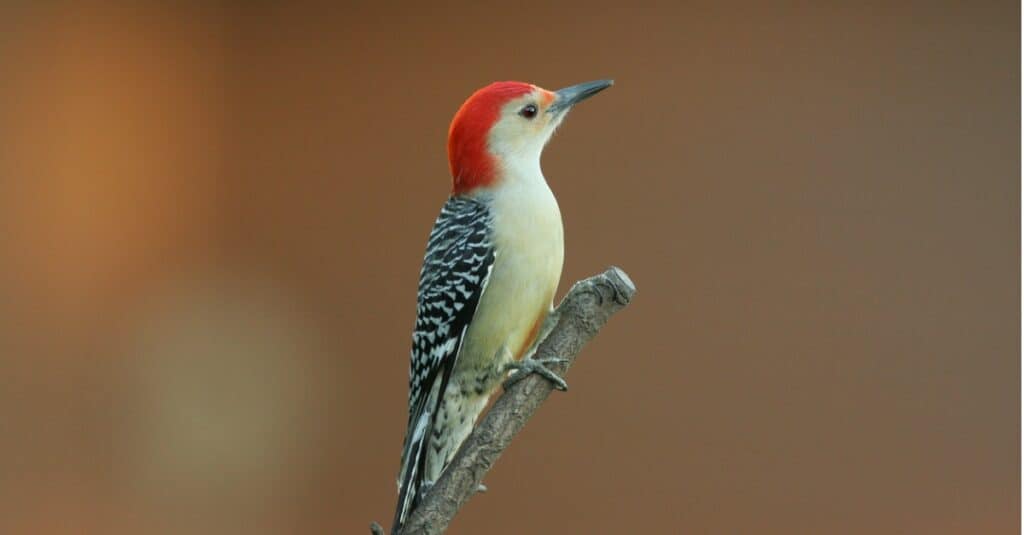
As confusing as the red head may be, the red-bellied woodpecker does, in fact, have a red belly.
©iStock.com/Flatcoater
The red-bellied woodpecker (Melanerpes carolinus) is a medium-sized bird that typically measures nine to 10½ inches in length.
When identifying this species, there are two field marks that stand out: their black and white striped back and the red patch found on their heads. Females have a red patch on the nape of the neck, while males have a red cap that extends down further along the neck. Additionally, the underside of the bird may have a faint red blush.
Red-bellied woodpeckers live in woodlands and forests in the Eastern United States. They typically forage on tree trunks and branches for beetles, ants, caterpillars, and other insects. They sometimes eat fruits, nuts, and berries in the winter.
Red-bellied woodpeckers are cavity nesters, meaning they excavate their own cavities in trees to make their nests. Both males and females work together to excavate the cavity and defend the nesting grounds from other birds. They typically lay between four to six white eggs that hatch after 12 days.
Despite its name, the red patch found on the head of red-bellied woodpeckers is often much less visible than other features, such as its black and white striped back. It is a common bird throughout its range and is listed as a species of least concern by the International Union for Conservation of Nature (IUCN).
Red-Headed Woodpecker
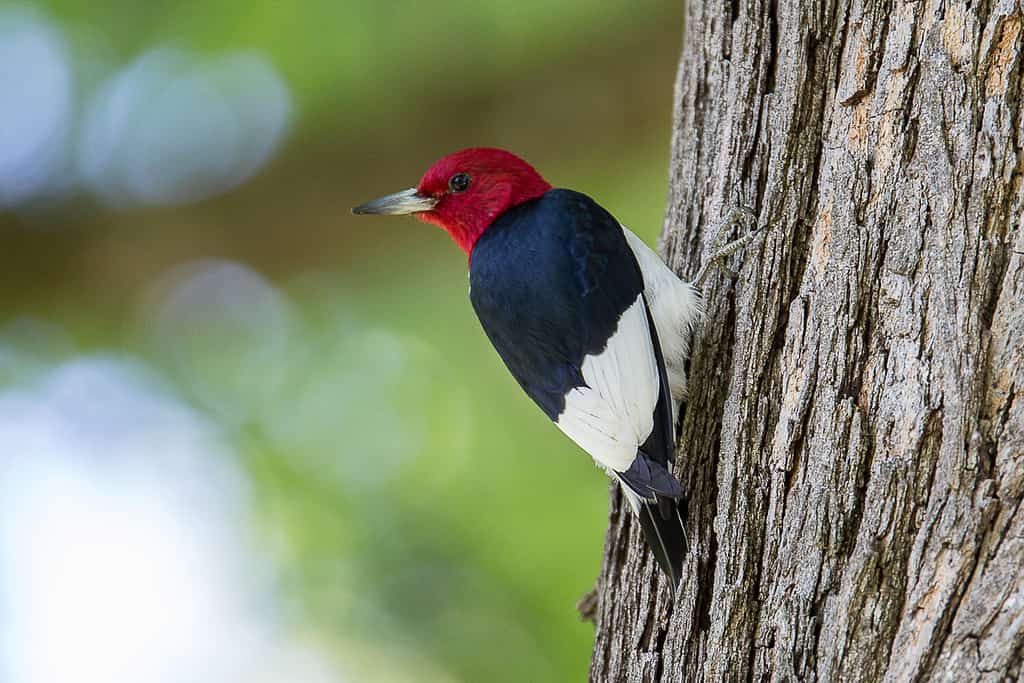
In Illinois, the red-headed woodpecker migrates. You can sometimes see them in the winter.
©Benjamin King/Shutterstock.com
The red-headed woodpecker is a medium-sized woodpecker measuring 8½ to 9½ inches in length. Its scientific name is Melanerpes erythrocephalus. The bird is easily identifiable by its solid red head, black back and tail, white undersides, wing patches, and rump patches. Males and females have similar plumage.
Red-headed woodpeckers inhabit open woodlands, orchards, and wooded suburbs with trees of varying sizes and ages. They feed on insects, nuts, and fruits and often use small branches of trees to forage for food. Unlike other woodpeckers, they also eat some grains and seeds.
The red-headed woodpecker is a cavity nester, meaning it creates nesting cavities in dead trees. These cavities provide homes for other animals, including bluebirds, chickadees, and tree swallows. Both males and females work together to create the nest.
Red-headed woodpeckers are important members of the ecosystem and play a vital role in keeping insect populations in check. They are also great indicators of a healthy habitat since their presence indicates that a healthy tree population is available for nesting. As such, they serve as an important indicator species for the health of our forests.
Northern Flicker

At 14 inches, the northern flicker is a large woodpecker with gorgeous plumage.
©FotoRequest/Shutterstock.com
The northern flicker is a large woodpecker and is approximately 12 to 14 inches in length. It has two field marks that are used to identify it: a brown striped back and a white patch on its rump. Both males and females have black collars, black spots on the underside, and a red patch on the back of their heads. Flickers have a yellowish hue on the tails and wings that can be seen only when the birds are in flight. Males have an additional feature, a black “mustache” that differentiates them from females.
Flickers are omnivorous, eating both insects and fruits. They primarily feed on the ground, flicking their wings to stir up bugs and then catching them in their bills. When available, they feed on fruits, berries, and nuts. They also store acorns and other nuts in crevices in trees to eat later in the winter months.
Flickers live throughout North America, from Alaska and Canada to Central America. You can commonly find them in open woodlands, forest edges, orchards, parks, and suburban areas. You will notice the alone or in pairs, and you will hear them in flight by their distinctive “wick-a-wick-a-wick” sound.
Northern flickers mate in April or May and are monogamous for the season. The female builds a nest in a tree cavity or in a nest box, and she will lay between 4 to 8 eggs. Both the male and female will take turns incubating the eggs and caring for the young. Flickers are highly territorial and will defend their nest vigorously.
Pileated Woodpecker

Look no further than Illinois for the pileated woodpecker. They are year-round residents in this state.
©iStock.com/Harry Collins
The pileated woodpecker is the largest woodpecker in Illinois, measuring 16 to 19½ inches in length. It is easily recognizable by its two markings: the red crest along its head and the white patches under its wings. Male pileated woodpeckers have a crest of pure red and a red “mustache,” while females have a black forehead, red crest, and no mustache-like plumage.
In addition to its size and distinctive field marks, the pileated woodpecker has a loud, striking call, which some compare to a laugh. They also make a loud drumming sound when they are excavating nesting cavities in dead or dying trees.
The pileated woodpecker is also an important part of the ecosystem, as it plays a critical role in controlling populations of insects such as carpenter ants. It also helps to disperse seeds as it eats fruit, nuts, and acorns.
Woodpecker Behavior
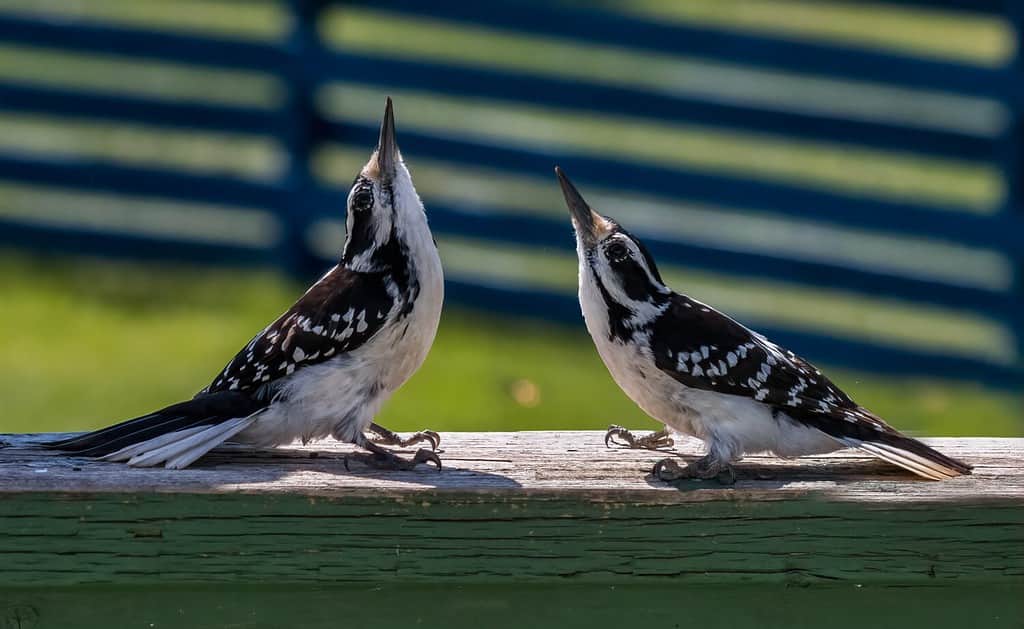
That drumming sound that you hear woodpeckers making is often a noise they use to attract mates.
©Fiona M. Donnelly/Shutterstock.com
Woodpeckers don’t use songs to attract a mate like other birds do. Instead, they exhibit drumming behavior which is often heard in urban areas. This can be on antennas, siding, gutters, and eaves. Once they find a mate, the drumming usually stops. Woodpeckers are also known to drill into trees and other wood structures in search of insects. During the spring and again in the fall, they will dig out cavities for nesting and protection from winter weather.
Yellow-bellied sapsuckers usually do not drill on buildings but can cause harm to trees. They make a pattern of horizontal or vertical rows on the same tree and favor birch, pine, spruce, and fruit trees. These birds may revisit the same trees during spring and fall migration, leading to further damage. These holes can weaken the tree and make it more prone to insect infestation or illness.
Woodpeckers are instrumental in eliminating certain insects, so it is necessary to retain dead trees for them to inhabit. This is not only important for the woodpeckers, but other species, such as nuthatches and chickadees, also take advantage of the abandoned woodpecker nests.
Woodpeckers in Illinois: Reproduction
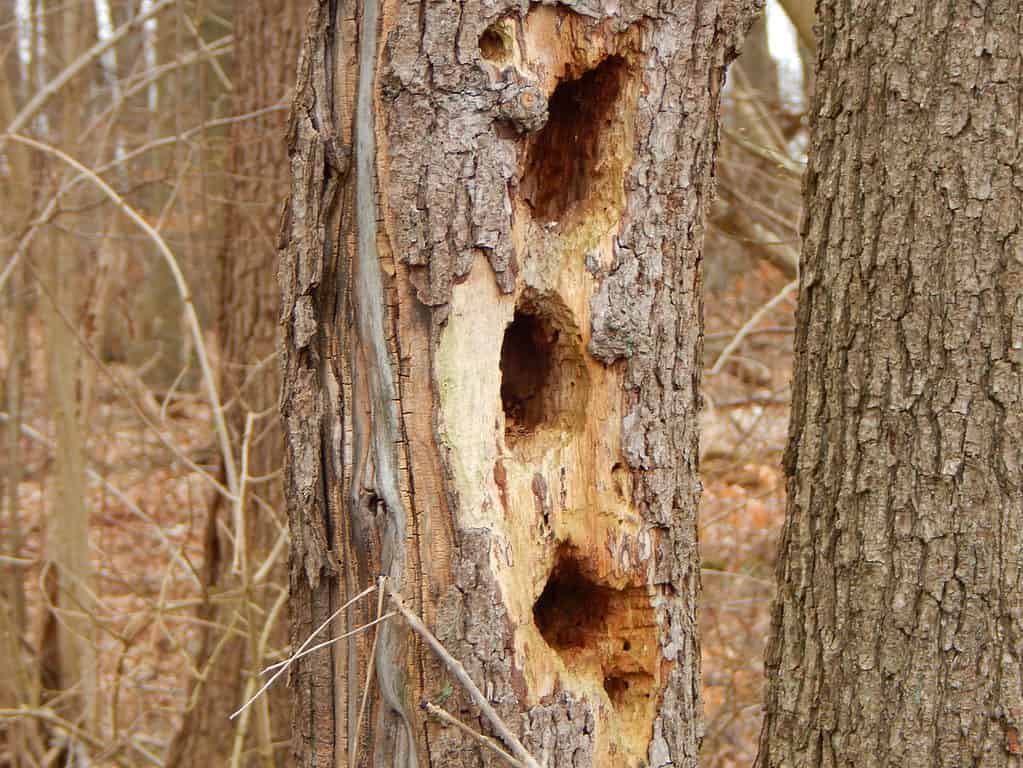
Often holes in trees are home to baby woodpeckers.
©iStock.com/Kurt-Erik Goehner
Woodpecker couples typically form during late winter or early spring, and then they create their own breeding territories. The birds use existing cavities in either living or dead trees to make their nests, but if those aren’t available, they will sometimes settle for fence posts, utility poles, or appropriately sized birdhouses (such as for the northern flicker and red-bellied woodpecker).
Digging out an appropriate spot takes about a week or two. After that, the female lays anywhere from three to eight white eggs directly on the woodchips. Incubating the eggs ranges from eleven to fourteen days for most species, but pileated woodpeckers take closer to eighteen. Both parents feed the chicks until they are old enough to leave the nest. This is typically around twenty to thirty days old. Some species can even raise two broods during a single season.
Woodpeckers in Illinois: A Federally Protected Bird
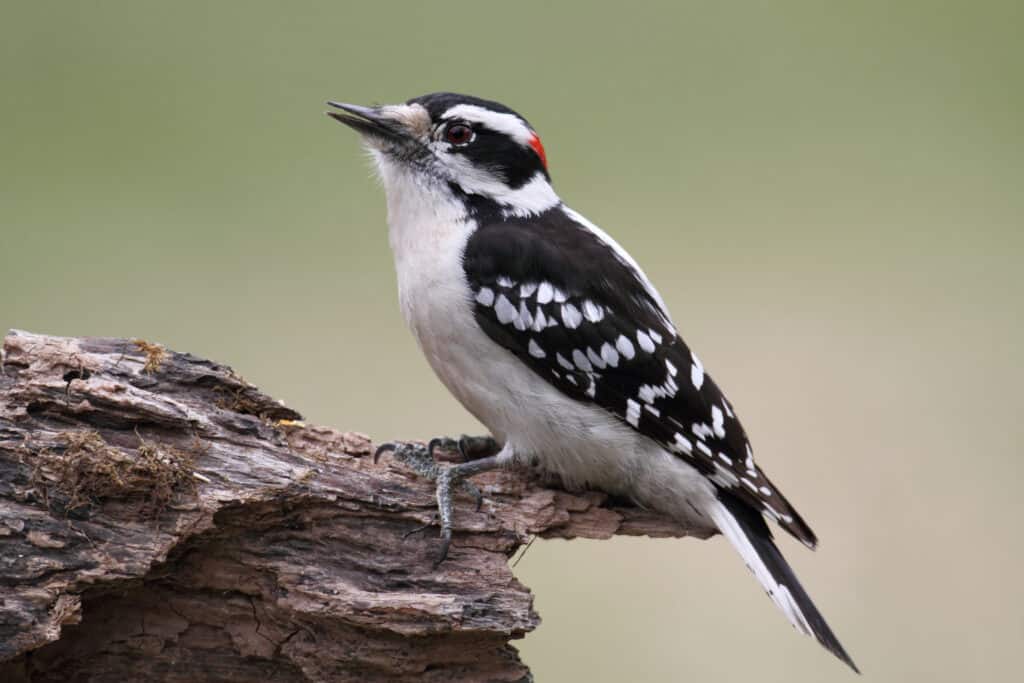
Woodpeckers are federally protected birds. It is illegal to kill them.
©Steve Byland/Shutterstock.com
Living close to woodlands and other natural environments can be great for spotting birds and other wildlife. You may think about calling a pest control company to deal with woodpecker activity near your home. But before you do, remember that almost all of these birds are native to the US. Their nests and eggs are protected by the Migratory Bird Treaty Act, which has been in effect since 1918. This law protects over a thousand species of birds, including woodpeckers.
If you feel like you must address the woodpecker activity, connect with a local Migratory Birds Program contact to speak to a wildlife professional and learn about legal solutions.
The most successful way to keep woodpeckers away from a building is to install bird netting around the outside of it, from the outer eaves to the side. The netting should be stretched tightly and checked regularly for any holes that may have formed over time. Bird netting is available in many hardware and farm supply stores, as well as online, and you can select types that are almost invisible.
The photo featured at the top of this post is © Mike Truchon/Shutterstock.com
Thank you for reading! Have some feedback for us? Contact the AZ Animals editorial team.







